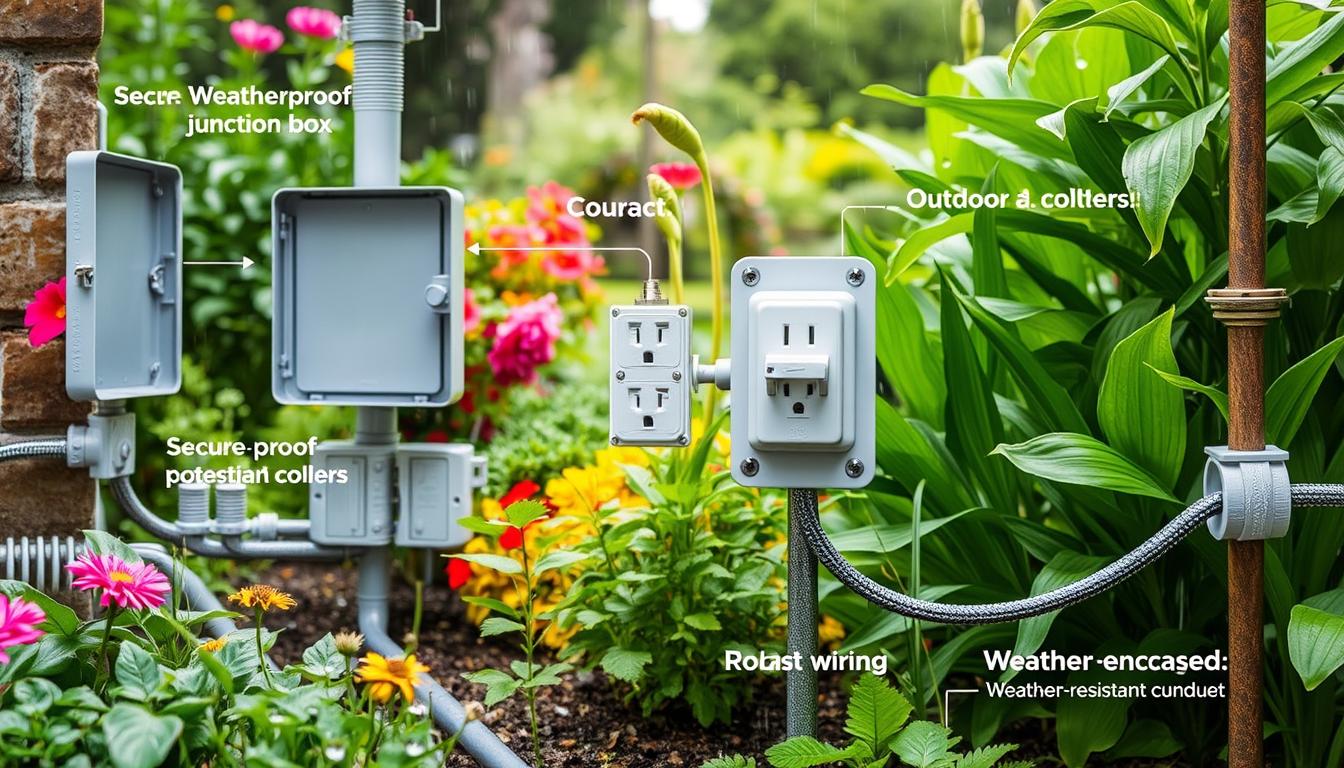Protecting outdoor electrical systems from the weather is key for safety and reliability. Weather-proof solutions are vital for exterior outlets and outdoor electrical systems. This article will cover why these solutions are important, including the basics of outdoor electrical systems and safety tips.
Outdoor electrical systems face many weather challenges. They need protection from rain, snow, and extreme temperatures. Weather-proof solutions help these systems work safely and efficiently. They make outdoor living spaces, like landscape lighting, safe and enjoyable.
Choosing weather-proof solutions keeps outdoor electrical systems safe and working well, even in bad weather. This includes using materials and components that can handle the weather, like GFCI outlets and weather-proof boxes. Next, we’ll look into outdoor electrical installations, safety, and weather-resistant materials.
Key Takeaways
- Weather-proof solutions are essential for outdoor electrical installations to ensure safety and reliability.
- Exterior outlets and outdoor electrical systems require protection from various weather conditions.
- Weather-proof solutions provide a reliable and safe way to enjoy outdoor living spaces.
- Investing in weather-proof solutions can help prevent electrical hazards and ensure compliance with outdoor electrical codes.
- Weather-resistant materials and components, such as GFCI outlets, are crucial for outdoor electrical systems.
- Regular maintenance and inspections are necessary to ensure the longevity and safety of outdoor electrical systems.
Understanding Outdoor Electrical Systems
Outdoor electrical systems are key for homes and buildings. They power things like lights, pool gear, and outdoor kitchens. A good setup makes a place look and work better, while keeping it safe and efficient. It’s also important to protect these systems from the weather.
Outdoor electrical setups include wiring, outlets, and circuit breakers. These must handle outdoor weather like rain, snow, and heat. Weather protection stops electrical dangers and fires. These systems are used for lights, powering outdoor gear, and for pools and hot tubs.
Basic Components of Exterior Electrical Setup
- Wiring and cables
- Outlets and receptacles
- Circuit breakers and GFCI protection
Importance of Weather Protection
Weather protection is key for outdoor electrical systems. It keeps them safe from rain, snow, and heat. Using weather-resistant materials and regular checks help avoid big problems.
Common Applications and Uses
Outdoor electrical systems are used for many things. This includes lights, powering outdoor gear, and for pools and hot tubs. Knowing about these systems and weather protection helps make safe and efficient setups. This adds value to a property.
| Component | Description |
|---|---|
| Wiring and cables | Designed to withstand outdoor weather conditions |
| Outlets and receptacles | Weather-resistant and GFCI-protected |
| Circuit breakers | Provide overload protection and prevent electrical shock |
Essential Safety Considerations for Exterior Power
When dealing with exterior power, safety considerations are key. Electrical shock, fires, and other dangers can happen if we don’t take the right steps. It’s vital to think about the risks of exterior power and how to avoid them.
Important safety considerations include using ground fault circuit interrupters (GFCIs) and other safety tools. GFCIs stop electricity flow in case of a ground fault, preventing shock. Also, electrical protection devices like surge protectors and circuit breakers can protect your gear and lower fire risks.
Here are some tips for safe outdoor electrical setups:
- Use GFCIs and other safety devices to prevent electrical shock
- Install exterior power outlets and switches in weather-proof enclosures
- Keep electrical equipment and cords away from water and moisture
- Use electrical protection devices such as surge protectors and circuit breakers
By following these safety considerations and precautions, you can ensure safe and reliable exterior power setups. Always check with a licensed electrician if you’re unsure about outdoor electrical work.
Remember, electrical protection is not just about avoiding accidents. It also helps your outdoor electrical gear last longer. By taking the right safety considerations and using proper electrical protection devices, you can make your equipment last longer and save on repairs.
| Device | Purpose | Importance |
|---|---|---|
| GFCI | Prevents electrical shock | High |
| Surge Protector | Protects against power surges | Medium |
| Circuit Breaker | Prevents electrical fires | High |
Weather-Resistant Materials and Components
Outdoor electrical setups need weather-resistant materials and components for safety and reliability. This means using weather-resistant materials that can handle extreme temperatures, humidity, and sunlight.
GFCI outlets are key in outdoor electrical systems. They protect against electrical shock and are needed where water might be present, like near pools or in outdoor kitchens. GFCI outlets are a crucial safety measure to prevent electrical accidents.
Key Components for Outdoor Electrical Systems
- Weather-proof boxes to protect electrical connections and components
- GFCI outlets to prevent electrical shock
- Conduit types, such as PVC or metal, to protect electrical cables
Using weather-proof boxes is also crucial. These boxes keep electrical connections and components dry and safe from the weather. They are designed to be waterproof and can handle extreme weather, keeping the electrical system safe and working well.
In summary, for outdoor electrical setups, it’s vital to use weather-resistant materials and components like GFCI outlets and weather-proof boxes. Choosing the right materials ensures a safe and reliable electrical system that can handle different weather conditions.
| Component | Description |
|---|---|
| GFCI Outlets | Protect people from electrical shock |
| Weather-Proof Boxes | Protect electrical connections and components |
| Conduit Types | Protect electrical cables from damage |
Professional Installation Requirements
For outdoor electrical systems, professional installation is key for safety and efficiency. A licensed electrician brings many benefits. They use top-quality materials and follow local electrical codes. This is vital for outdoor electrical systems, which face different weather conditions.
A pro installation includes important safety measures. This includes using personal protective equipment (PPE) and proper grounding. It prevents accidents and ensures the system works right. Some key points for professional installation are:
- Following local electrical codes and regulations
- Using weather-resistant materials and components
- Installing GFCI outlets and circuit breakers correctly
Choosing professional installation means a safe and reliable outdoor electrical system. It also avoids hazards and expensive fixes.
A well-designed and professionally installed outdoor electrical system boosts a property’s value and function. It also gives homeowners peace of mind.
Outdoor Electrical Code Compliance
Ensuring outdoor electrical installations meet the code is key for safety and reliability. The national electric code sets guidelines for outdoor electrical systems. Following these guidelines helps avoid electrical shocks, fires, and other dangers.
The outdoor electrical code aims to protect people and property from electrical risks. It requires the use of weather-resistant materials and components. Local regulations also ensure outdoor electrical installations meet safety standards.
National Electric Code Guidelines
The national electric code outlines safe electrical system installation, including outdoor use. It covers wiring, grounding, and bonding. Following this code ensures outdoor electrical systems are safe and reliable.
Local Regulations and Permits
Local regulations and permits are also needed for outdoor electrical work. These rules vary by location and ensure installations meet local safety standards. Getting the right permits and following local rules is crucial to avoid fines and ensure compliance.
Inspection Requirements
Regular inspections by a qualified electrician are vital for outdoor electrical systems. These checks should include wiring, grounding, and bonding. Inspection needs differ by location, so it’s important to check with local authorities.
By adhering to the outdoor electrical code, national electric code, and local regulations, installations can be safe and reliable. This protects people and property and prevents electrical hazards. It also ensures compliance with safety standards.
| Code Requirement | Description |
|---|---|
| National Electric Code | Provides guidelines for the safe installation of electrical systems |
| Local Regulations | Vary by location and are designed to ensure that electrical installations meet specific safety standards |
| Inspection Requirements | Regular inspections are necessary to ensure that outdoor electrical installations remain safe and reliable |
Landscape Lighting and Power Distribution
Landscape lighting can make your outdoor space look amazing and work better. You need to think about how to power your lights. This means planning the outdoor wiring and conduit for your system.
Using energy-saving lights is a smart move. It cuts down on energy use and saves money on bills. LED lights, solar lights, and low-voltage systems are good choices.
Here are some tips for setting up your landscape lighting:
- Look at your outdoor area to find the best spots for lights
- Pick energy-saving lights that match your budget and needs
- Plan the power distribution and outdoor wiring for your system
- Think about getting a pro to install your lights
By following these tips, you can make a beautiful and useful outdoor area. It will also increase your home’s value.
Protecting Your Outdoor Electrical Investments
To keep your outdoor electrical systems safe and working well, it’s key to focus on protection and upkeep. Regular checks and a good maintenance plan can stop weather damage and lower electrical danger risks. By making smart choices in outdoor electrical investments, you can enjoy the perks of power outside while avoiding big risks.
One important step is to set up a maintenance schedule. This means checking wiring, outlets, and other parts often to catch problems early. It’s also vital to prevent weather damage, as bad weather can harm your outdoor electrical systems.
Maintenance Schedule Guidelines
- Inspect wiring and connections for signs of wear or damage
- Check outlets and switches for proper function and security
- Verify that all components are securely fastened and protected from the elements
By sticking to these tips and taking steps to prevent weather damage, you can protect your outdoor electrical investments. This ensures they work well all year. Always check local rules and advice for specific maintenance and protection needs for outdoor electrical systems.
Troubleshooting Common Outdoor Electrical Issues
When facing outdoor electrical issues, safety is key to avoid dangers. Troubleshooting these problems can be tough. But, with the right steps, you can find and fix them quickly.
Common outdoor electrical issues include bad wiring, faulty outlets, and broken circuit breakers. Start by looking at the wiring and connections for damage or wear.
- Check the wiring and connections for any signs of damage or wear
- Verify that all outlets and switches are functioning correctly
- Check the circuit breakers to ensure they are not tripped or damaged
Always follow safety measures when fixing outdoor electrical issues. Turn off power to the area and wear PPE. These steps keep you safe and help you solve problems efficiently.
Smart Technology Integration for Exterior Power
Outdoor electrical systems are getting smarter. Smart technology is key for managing power outside. It makes energy use better and life easier.
Smart tech lets you control lights, heat, and cool from anywhere. This saves energy and makes your outdoor space better. For example, smart lights adjust to the day and mood.
Automated Control Systems
Smart systems use sensors to control your outdoor setup. They make sure everything works well and saves energy. You can:
- Control your outdoor systems from anywhere
- Get alerts for upkeep and fixes
- Change settings to fit your mood
Energy Efficiency Solutions
Smart tech brings energy-saving options to your outdoor power. LED lights and heat pumps cut down energy use. They also help find ways to use less energy.
Smart tech and energy-saving ideas make outdoor power better. They help the planet and save money.
Cost Considerations and Long-term Value
When thinking about outdoor electrical setups, cost considerations are key. People want to get the most for their money. Spending on quality materials and expert installation might seem pricey at first. But, it can save you money in the long run.
A good outdoor electrical system brings many benefits. It makes your space safer, uses less energy, and lasts longer. For example, using materials that can stand up to the weather can save you from expensive fixes later. Plus, a pro install makes sure it follows local rules, avoiding fines.
When looking at the cost considerations of an outdoor electrical system, consider these points:
- Initial installation costs
- Energy efficiency and potential savings
- Maintenance and repair costs
- System lifespan and durability
Looking at outdoor electrical installations as a whole helps make smart choices. It balances the initial cost with long-term benefits. A well-done system can last for years, making it a smart investment for any property.
By focusing on quality and professionalism in outdoor electrical setups, property owners can have a safe, efficient, and cost-effective system. It meets their needs and improves their life quality.
Conclusion: Ensuring Safe and Reliable Outdoor Electrical Systems
As we wrap up our look at outdoor electrical setups, it’s clear that safety and reliability are key. Outdoor electrical systems need careful design and upkeep to face the weather and keep everyone safe. Using weather-proof materials and following safety rules, along with hiring pros, helps make outdoor power reliable.
It’s also vital to check your systems often, keep them in good shape, and watch for seasonal changes. With the right steps and a focus on quality, your outdoor power will keep working well for many years.


